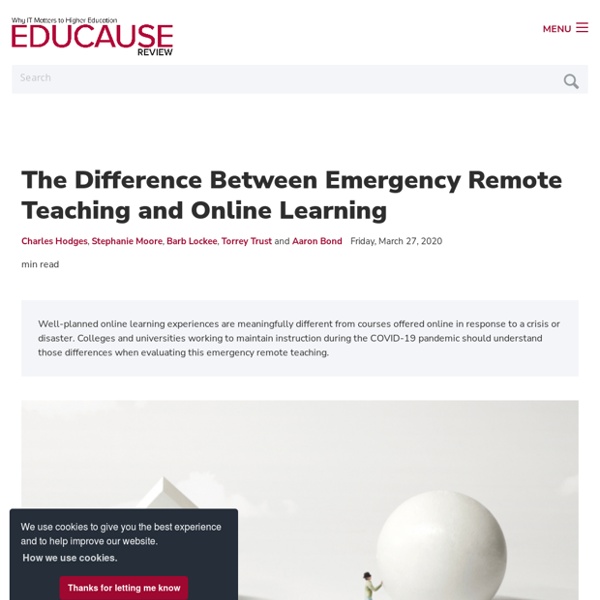How to create a SCORM course
After reading this article, you’ll know what SCORM is and how to turn a simple PowerPoint presentation into a SCORM course and upload it into a learning management system. For a quick overview of SCORM, watch the video below. Skip it to the article if you prefer more comprehensive details. What Is SCORM?
Virtual Education Dilemma: Scheduled Classroom Instruction vs. Anytime Learning
With schools shut down across America, K-12 teachers faced with a question many likely thought they'd never have to ask: When and how often during the school day do my students need to see me? Distance education can be broken down into two broad approaches: synchronous and asynchronous. The former consists of the teacher offering a lesson to the class of students at the same time; the latter provides the student with tools to complete the work on their own time, and direct involvement from the teacher can happen anytime. (For more details, check out this guide from Wisconsin educators, such as Diane Doersch, the technical project director for Digital Promise and a former chief technology officer in public schools. And read this guide from Educause about research on the two different approaches.) The bottom line: Neither approach is sufficient all on its own, but there are situations and subjects that do tend to favor one of the two strategies.
Teaching about mental wellbeing
This training module supports the physical health and mental wellbeing section of the statutory relationships, sex and health education curriculum. This is the first of a series of 14 modules to support schools to implement the new curriculum. We have developed this mental wellbeing teacher training module to help subject leads and teachers understand what they should teach, as well as improving their confidence in delivering mental wellbeing as part of the new curriculum. The new curriculum becomes statutory in September 2020 but the content in this module may be useful for teachers who are currently working with pupils, either face-to-face or remotely, to support them to maintain good mental health and address issues before they escalate.
2017 Métiers, nouveaux métiers de la formation à distance
Hervé Daguet, Martine Vidal et Jacques Wallet Béatrice Savarieau et Julie Guégan Community Manager: which new player in distance learning? Elizabeth Armao Méliet The evolution of pedagogical engineering jobs: which adequacy between the new needs and the trainings which are available? Georges Ferone Effects of distance learning on teacher practices and skills in Higher Education Patrick Guillemet Approche en contexte québécois Nicole Racette, Bruno Poellhuber et Marie-Pierre Bourdages-Sylvain What are the characteristics of tutor’s employment and work in open and distance learning?
What is Remote Learning?
Excerpted from "The Just in Time Playbook for Remote Learning" by Dr. Kecia Ray The officially identified pandemic of COVID-19 is impacting more than 376 million students worldwide (see UNESCO’s website for updated reports of school closures).
Game-based Learning and Gamification: What’s the Difference?
When you talk of games and e-learning, the terms that come to mind are gamification and game-based learning. These terms are used interchangeably when talking about games but they are actually quite distinct. This blog will define these terms, and help you discover the differences between them. The Difference Game-based learning is the use of games to achieve an instructional goal.
Designing for Online Learning
Registration closes at 7pm ET on June 18. This course is also offered August 3 - 8. Please see our full menu of educator courses in the Designing for Online Learning Series here.
Google Chrome’s Link to Text Fragment extension – Top Tools for Learning
A recent article in MakeUseOf, You can now link to specific text on a website explains “If you have ever wanted to share an article with someone but direct them to a specific part, you’ll love Google’s new Chrome extension. It’s called Link to Text Fragment, and it allows you to link to specific text on a website.
Optimal Video Length for Student Engagement
Hi, I’m Philip Guo, an assistant professor of Computer Science at the University of Rochester. Since my research interests are in human-computer interaction and online education, I was really excited when Anant Agarwal (edX President) and Rob Rubin (VP of Engineering) invited me to spend the past summer at edX as a visiting research scientist. Anant, Rob, and the rest of the edX leadership team have been wonderfully supportive of my research efforts. In addition, Anant and Rob have personally contributed to framing some of the questions that I investigated in my work. I plan to blog about my findings in the coming months.
What is Remote Learning and How to Implement it in Your Organization
The way we work has changed and it’s continuing to change. People are working remotely; being active parts of their team no matter where they are. With this change, traditional, in-person training no longer fits the bill. Not only is it restrictive and costly, it doesn’t work for modern businesses. Here’s where remote learning comes in.
The Future of E-Learning
Here’s an excerpt from a recent presentation on the future of learning technology. I went to school to be a video producer. Right after I graduated, the video industry changed from analog to digital.



